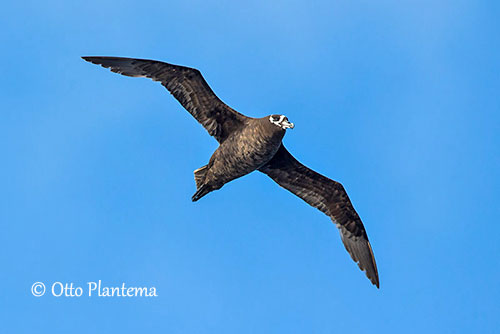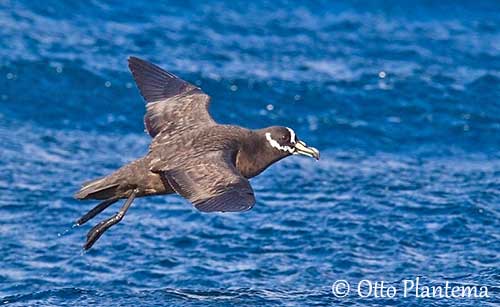
Fr: Pétrel à lunettes
Ang: Spectacled Petrel
All: Brillesturmvogel
Esp: Petrel Mentón Blanco de Tristán da Cunha
Ita: Petrello dagli occhiali
Nd: Brilstormvogel
Sd: Glasögonpetrell
Photographer:
Otto Plantema
Trips around the world
Text by Nicole Bouglouan
Sources:
HANDBOOK OF THE BIRDS OF THE WORLD vol 1 by Josep del Hoyo-Andrew Elliot-Jordi Sargatal - Lynx Edicions - ISBN: 8487334105
A Complete Guide to Antarctic Wildlife by Hadoram Shirihai and Illustrated by Brett Jarrett - Edited by Guy M. Kirwan - ALUL.A Press Oy, Finland - ISBN 9519894705
BirdLife International (BirdLife International)
Ocean Wanderers "Ride the Wave"
Biodiversity Explorer – The Web of Life in Southern Africa
Wikipedia, the free encyclopaedia
Page family Procellariidae
Summary cards
Spectacled Petrel
Procellaria conspicillata
Procellariiformes Order – Procellariidae Family
INTRODUCTION:
The Spectacled Petrel was formerly a subspecies of the White-chinned Petrel (P. aequinoctialis), but they differ in head pattern, vocalizations and range.
This species is one of the largest petrels nesting in burrows. Its breeding range is restricted to Inaccessible Island in the Tristan da Cunha archipelago in S Atlantic Ocean.
The Spectacled Petrel has small population size but slightly increasing with 20,000/50,000 individuals. However, this species remains vulnerable to long-line fishing which is the major threat.

RANGE:
The Spectacled Petrel breeds on Inaccessible Island in the Tristan da Cunha archipelago, in S Atlantic Ocean.
Outside the breeding season, it disperses widely at sea over the S Atlantic Ocean, over an area extending from the E coast of South America, to the W coast of South Africa.
HABITAT:
The Spectacled Petrel breeds between 380 and 500 metres of elevation on high plateau on Inaccessible Island, usually in wet, marshy areas and along sides of river valleys where it can excavate the nesting burrow.
At sea, it frequents deeper and warmer waters than the White-chinned Petrel.
CALLS AND SONGS:
The Spectacled Petrel has deeper-pitched voice. Its repertoire includes harmonious complex groans. At colonies, it gives an advertisement call, a prolonged rattle, deeper and shorter than that of the White-chinned Petrel.
Differences in vocalizations are the main reason for full species status.
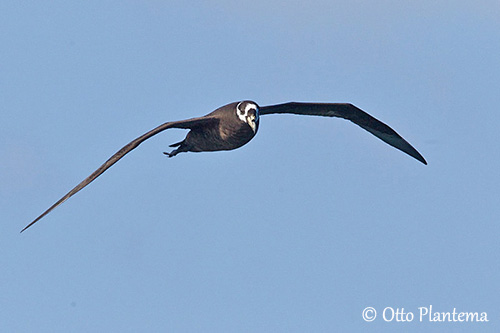
After the breeding season, the Spectacled Petrel disperses widely over the S Atlantic Ocean, between South America and South Africa. However, some of them may remain in the surrounding of the Tristan da Cunha archipelago all year round.
The flight is fast and powerful, with wingbeats interspersed with glides on stiff wings. In flight, the underwing may appear silvery.
REPRODUCTION OF THIS SPECIES:
The breeding season starts in late October/early November, about five weeks before the White-chinned Petrel. The chicks hatch in December and fledge in March. Then, they fly to the sea.
They excavate the burrow in wet health, sparse tussock grassland or under procumbent trees such as Phylica arborea, a native plant species.
The female lays a single white egg. Incubation and fledging periods are unknown. Both sexes share all the nesting duties and the young fledge though March.
In the White-chinned Petrel, the incubation lasts 57-62 days and both adults take turns of several days, suggesting that the breeding behaviour of the Spectacled Petrel is probably fairly similar.
The juvenile has a natural predator, the Brown Skua.
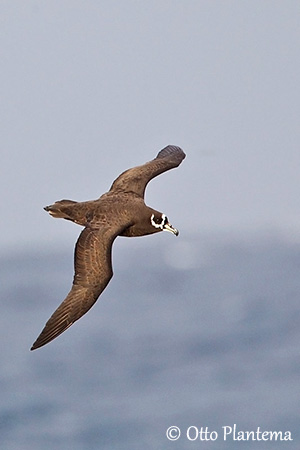
PROTECTION / THREATS / STATUS:
The Spectacled Petrel’s population has recovered significantly since 19th and early 20th centuries.
In 2007, the population was estimated at 20,000/50,000 individuals. But the major threat remains the long line fisheries’ impact on these birds, as numerous petrels are killed every year by bycatch. This species has restricted breeding range too, making these birds very vulnerable to natural events (storms) and human activities.
The Spectacled Petrel is currently listed as Vulnerable.
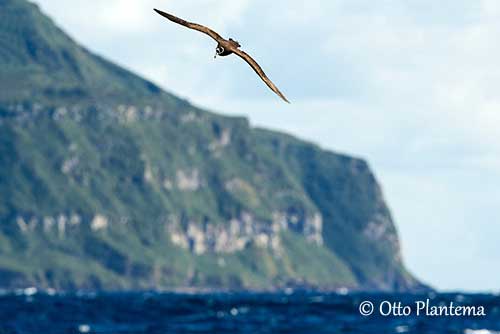
BEHAVIOUR IN THE WILD:
The Spectacled Petrel feeds mainly on squid, crustaceans and small fish. It also takes offal around the ships. It feeds by surface-seizing, grabbing the preys from the surface, and performs shallow dives. It feeds exclusively at sea.
The Spectacled Petrel nests in burrow between September and March. It breeds in loose colonies.
The courtship displays usually take place inside the burrow, and consist largely in “Billing” while oil is dribbling down the bill. They also perform mutual preening. Then, both mates may engage in series of long calls.
During the breeding season, they visit the colony at dusk, although they often start in the mid-afternoon.
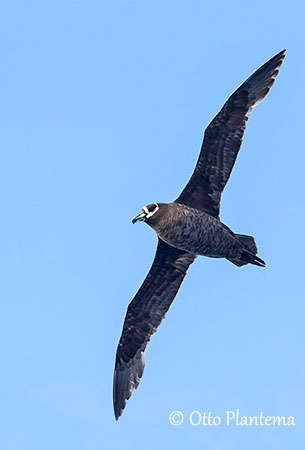
DESCRIPTION OF THE BIRD:
Biometrics:
Length: 55 cm
Weight: 1000-1300 g
The adult is a bulky bird with dark plumage and striking white head pattern.
The plumage is dark sooty-brown to blackish overall.
On the head, the white patches or “spectacles” make this species very different from the White-chinned Petrel. The broad white bands extend from the chin to behind, encircling the ear-coverts and sometimes connecting on the hindneck, and over the facial area on lores and forecrown. These markings may vary with each bird, and the spectacles can be sometimes incomplete.
The strong, hooked bill is pale yellow to horn, with conspicuous blackish linings to plates, nostrils and tip. The eyes are dark brown. Legs and webbed feet are blackish.
Both sexes are similar, with male larger than female.
The juvenile resembles adult.
